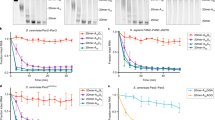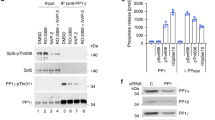Abstract
Decapping by Dcp2 is an essential step in 5′-to-3′ mRNA decay. In yeast, decapping requires an open-to-closed transition in Dcp2, though the link between closure and catalysis remains elusive. Here we show using NMR that cap binds conserved residues on both the catalytic and regulatory domains of Dcp2. Lesions in the cap-binding site on the regulatory domain reduce the catalytic step by two orders of magnitude and block the formation of the closed state, whereas Dcp1 enhances the catalytic step by a factor of 10 and promotes closure. We conclude that closure occurs during the rate-limiting catalytic step of decapping, juxtaposing the cap-binding region of each domain to form a composite active site. This work suggests a model for regulation of decapping where coactivators trigger decapping by stabilizing a labile composite active site.
This is a preview of subscription content, access via your institution
Access options
Subscribe to this journal
Receive 12 print issues and online access
$189.00 per year
only $15.75 per issue
Buy this article
- Purchase on Springer Link
- Instant access to full article PDF
Prices may be subject to local taxes which are calculated during checkout





Similar content being viewed by others
Accession codes
References
Schier, A.F. The maternal-zygotic transition: death and birth of RNAs. Science 316, 406–407 (2007).
Lindstein, T., June, C.H., Ledbetter, J.A., Stella, G. & Thompson, C.B. Regulation of lymphokine messenger RNA stability by a surface-mediated T cell activation pathway. Science 244, 339–343 (1989).
Shyu, A.B., Greenberg, M.E. & Belasco, J.G. The c-fos transcript is targeted for rapid decay by two distinct mRNA degradation pathways. Genes Dev. 3, 60–72 (1989).
Shaw, G. & Kamen, R. A conserved AU sequence from the 3′ untranslated region of GM-CSF mRNA mediates selective mRNA degradation. Cell 46, 659–667 (1986).
Hilgers, V., Teixeira, D. & Parker, R. Translation-independent inhibition of mRNA deadenylation during stress in Saccharomyces cerevisiae . RNA 12, 1835–1845 (2006).
Chowdhury, D. & Novina, C.D. RNAi and RNA-based regulation of immune system function. Adv. Immunol. 88, 267–292 (2005).
Isken, O. & Maquat, L.E. Quality control of eukaryotic mRNA: safeguarding cells from abnormal mRNA function. Genes Dev. 21, 1833–1856 (2007).
Wang, Z., Jiao, X., Carr-Schmid, A. & Kiledjian, M. The hDcp2 protein is a mammalian mRNA decapping enzyme. Proc. Natl. Acad. Sci. USA 99, 12663–12668 (2002).
Beelman, C.A. et al. An essential component of the decapping enzyme required for normal rates of mRNA turnover. Nature 382, 642–646 (1996).
Fenger-Grøn, M., Fillman, C., Norrild, B. & Lykke-Andersen, J. Multiple processing body factors and the ARE binding protein TTP activate mRNA decapping. Mol. Cell 20, 905–915 (2005).
Chen, C.Y. & Shyu, A.B. AU-rich elements: characterization and importance in mRNA degradation. Trends Biochem. Sci. 20, 465–470 (1995).
Amrani, N., Sachs, M.S. & Jacobson, A. Early nonsense: mRNA decay solves a translational problem. Nat. Rev. Mol. Cell Biol. 7, 415–425 (2006).
Chen, C.Y., Zheng, D., Xia, Z. & Shyu, A. Ago-TNRC6 triggers microRNA-mediated decay by promoting two deadenylation steps. Nat. Struct. Mol. Biol. 16, 1160–1166 (2009).
Eulalio, A. et al. Target-specific requirements for enhancers of decapping in miRNA-mediated gene silencing. Genes Dev. 21, 2558–2570 (2007).
Behm-Ansmant, I. et al. mRNA degradation by miRNAs and GW182 requires both CCR4:NOT deadenylase and DCP1:DCP2 decapping complexes. Genes Dev. 20, 1885–1898 (2006).
Rissland, O.S. & Norbury, C. Decapping is preceded by 3′ uridylation in a novel pathway of bulk mRNA turnover. Nat. Struct. Mol. Biol. 16, 616–623 (2009).
Heo, I. et al. TUT4 in concert with Lin28 suppresses microRNA biogenesis through pre-microRNA uridylation. Cell 138, 696–708 (2009).
Song, M.-G. & Kiledjian, M. 3′ terminal oligo U-tract-mediated stimulation of decapping. RNA 13, 2356–2365 (2007).
Shen, B. & Goodman, H.M. Uridine addition after microRNA-directed cleavage. Science 306, 997 (2004).
Stevens, A. & Maupin, M.K. A 5′—3′ exoribonuclease of Saccharomyces cerevisiae: size and novel substrate specificity. Arch. Biochem. Biophys. 252, 339–347 (1987).
Coller, J. & Parker, R. Eukaryotic mRNA decapping. Annu. Rev. Biochem. 73, 861–890 (2004).
Franks, T.M. & Lykke-Andersen, J. The control of mRNA decapping and p-body formation. Mol. Cell 32, 605–615 (2008).
Garneau, N.L., Wilusz, J. & Wilusz, C.J. The highways and byways of mRNA decay. Nat. Rev. Mol. Cell Biol. 8, 113–126 (2007).
Krogan, N.J. et al. Global landscape of protein complexes in the yeast Saccharomyces cerevisiae . Nature 440, 637–643 (2006).
Parker, R. & Sheth, U. P bodies and the control of mRNA translation and degradation. Mol. Cell 25, 635–646 (2007).
She, M. et al. Structural basis of dcp2 recognition and activation by dcp1. Mol. Cell 29, 337–349 (2008).
Deshmukh, M.V. et al. mRNA decapping is promoted by an RNA-binding channel in Dcp2. Mol. Cell 29, 324–336 (2008).
She, M. et al. Crystal structure and functional analysis of Dcp2p from Schizosaccharomyces pombe . Nat. Struct. Mol. Biol. 13, 63–70 (2006).
Mildvan, A.S. et al. Structures and mechanisms of Nudix hydrolases. Arch. Biochem. Biophys. 433, 129–143 (2005).
Bessman, M.J., Frick, D.N. & O'Handley, S.F. The MutT proteins or “Nudix” hydrolases, a family of versatile, widely distributed, “housecleaning” enzymes. J. Biol. Chem. 271, 25059–25062 (1996).
Piccirillo, C., Khanna, R. & Kiledjian, M. Functional characterization of the mammalian mRNA decapping enzyme hDcp2. RNA 9, 1138–1147 (2003).
Teixeira, D. & Parker, R. Analysis of P-body assembly in Saccharomyces cerevisiae . Mol. Biol. Cell 18, 2274–2287 (2007).
Sheth, U. & Parker, R. Targeting of aberrant mRNAs to cytoplasmic processing bodies. Cell 125, 1095–1109 (2006).
Sheth, U. & Parker, R. Decapping and decay of messenger RNA occur in cytoplasmic processing bodies. Science 300, 805–808 (2003).
Jones, B.N., Quang-Dang, D.-U., Oku, Y. & Gross, J.D. A kinetic assay to monitor RNA decapping under single-turnover conditions. Methods Enzymol. 448, 23–40 (2008).
Gabelli, S.B., Bianchet, M.A., Bessman, M.J. & Amzel, L.M. The structure of ADP-ribose pyrophosphatase reveals the structural basis for the versatility of the Nudix family. Nat. Struct. Biol. 8, 467–472 (2001).
Kalodimos, C.G. et al. Structure and flexibility adaptation in nonspecific and specific protein-DNA complexes. Science 305, 386–389 (2004).
von Hippel, P.H. & Berg, O.G. Facilitated target location in biological systems. J. Biol. Chem. 264, 675–678 (1989).
Floor, S., Jones, B. & Gross, J. Control of mRNA decapping by Dcp2: an open and shut case? RNA Biol. 5, 189–192 (2008).
Dunckley, T., Tucker, M. & Parker, R. Two related proteins, Edc1p and Edc2p, stimulate mRNA decapping in Saccharomyces cerevisiae . Genetics 157, 27–37 (2001).
Decker, C.J., Teixeira, D. & Parker, R. Edc3p and a glutamine/asparagine-rich domain of Lsm4p function in processing body assembly in Saccharomyces cerevisiae . J. Cell Biol. 179, 437–449 (2007).
Schutz, P. et al. Crystal structure of the yeast eIF4A-eIF4G complex: An RNA-helicase controlled by protein-protein interactions. Proc. Natl. Acad. Sci. USA 105, 9564–9569 (2008).
Caruthers, J.M. & McKay, D.B. Helicase structure and mechanism. Curr. Opin. Struct. Biol. 12, 123–133 (2002).
Gu, M. et al. Insights into the structure, mechanism, and regulation of scavenger mRNA decapping activity. Mol. Cell 14, 67–80 (2004).
Wang, Z. & Kiledjian, M. Functional link between the mammalian exosome and mRNA decapping. Cell 107, 751–762 (2001).
Mori, S., Abeygunawardana, C., Johnson, M.O. & van Zijl, P.C. Improved sensitivity of HSQC spectra of exchanging protons at short interscan delays using a new fast HSQC (FHSQC) detection scheme that avoids water saturation. J. Magn. Reson. B. 108, 94–98 (1995).
Card, P.B. & Gardner, K.H. Identification and optimization of protein domains for NMR studies. Methods Enzymol. 394, 3–16 (2005).
Ferentz, A.E. & Wagner, G. NMR spectroscopy: a multifaceted approach to macromolecular structure. Q. Rev. Biophys. 33, 29–65 (2000).
Hura, G.L. et al. Robust, high-throughput solution structural analyses by small angle X-ray scattering (SAXS). Nat. Methods 6, 606 (2009).
Svergun, D.I. Determination of the regularization parameter in indirect-transform methods using perceptual criteria. J. Appl. Crystallogr. 25, 495–503 (1992).
Putnam, C.D., Hammel, M., Hura, G.L. & Tainer, J.A. X-ray solution scattering (SAXS) combined with crystallography and computation: defining accurate macromolecular structures, conformations and assemblies in solution. Q. Rev. Biophys. 40, 191–285 (2007).
Glatter, O. & Kratky, O. Small Angle X-ray Scattering (Academic Press, London, 1982).
Lee, B. & Richards, F.M. The interpretation of protein structures: estimation of static accessibility. J. Mol. Biol. 55, 379–400 (1971).
Collaborative Computational Project. N. The CCP4 suite: programs for protein crystallography. Acta Crystallogr. D Biol. Crystallogr. 50, 760–763 (1994).
Chothia, C. The nature of the accessible and buried surfaces in proteins. J. Mol. Biol. 105, 1–12 (1976).
Edgar, R.C. MUSCLE: multiple sequence alignment with high accuracy and high throughput. Nucleic Acids Res. 32, 1792–1797 (2004).
Waterhouse, A.M., Procter, J.B., Martin, D.M.A., Clamp, M. & Barton, G.J. Jalview Version 2–a multiple sequence alignment editor and analysis workbench. Bioinformatics 25, 1189–1191 (2009).
Acknowledgements
We thank M. Kelly for NMR support; K. Krukenberg as well as beamline scientists G. Hura and M. Hammel of Beamline 12.3.1 at the Advanced Light Source for assistance with SAXS experimentation and data analysis; and J.J. Miranda, M. Pufall, G. Narlikar and D. Morgan for critical reading of the manuscript. This work was supported by US National Institutes of Health grant R01GM078360 to J.D.G. S.N.F. received support from the Sandler Family Foundation for Basic Sciences and the Achievement Awards for College Scientists Foundation. B.N.J. was supported by a National Science Foundation predoctoral fellowship. G.A.H. was a student in the University of California, San Francisco Summer Research Training Program. The Advanced Light Source is supported by US Department of Energy Contract No. DE-AC02-05CH11231.
Author information
Authors and Affiliations
Contributions
S.N.F. designed and performed experiments, analyzed data, wrote the manuscript and prepared the figures; B.N.J. performed an experiment; G.A.H. generated Dcp2 mutants; J.D.G. supervised the project and experimental design and guided manuscript preparation.
Corresponding author
Ethics declarations
Competing interests
The authors declare no competing financial interests.
Supplementary information
Supplementary Text and Figures
Supplementary Figures 1–6, Supplementary Table 1 and Supplementary Note (PDF 1445 kb)
Rights and permissions
About this article
Cite this article
Floor, S., Jones, B., Hernandez, G. et al. A split active site couples cap recognition by Dcp2 to activation. Nat Struct Mol Biol 17, 1096–1101 (2010). https://doi.org/10.1038/nsmb.1879
Received:
Accepted:
Published:
Issue Date:
DOI: https://doi.org/10.1038/nsmb.1879
This article is cited by
-
Structure of the activated Edc1-Dcp1-Dcp2-Edc3 mRNA decapping complex with substrate analog poised for catalysis
Nature Communications (2018)
-
Structure of the active form of Dcp1–Dcp2 decapping enzyme bound to m7GDP and its Edc3 activator
Nature Structural & Molecular Biology (2016)
-
Structural basis of mRNA-cap recognition by Dcp1–Dcp2
Nature Structural & Molecular Biology (2016)
-
mRNA decapping in 3D
Nature Structural & Molecular Biology (2016)
-
Structure of the Dcp2–Dcp1 mRNA-decapping complex in the activated conformation
Nature Structural & Molecular Biology (2016)



